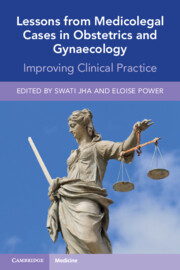Book contents
- Lessons from Medicolegal Cases in Obstetrics and Gynaecology
- Lessons from Medicolegal Cases in Obstetrics and Gynaecology
- Copyright page
- Dedication
- Contents
- List of Contributors
- Preface
- Foreword
- Chapter 1 Recent Trends in Clinical Negligence Claims in England
- Chapter 2 From Complaint to Litigation
- Chapter 3 Being a Medicolegal Expert and Report Writing
- Chapter 4 Consent: Legal and Clinical Implications
- Chapter 5 Prenatal Diagnosis, Screening and Wrongful Birth
- Chapter 6 Obstetric Perineal Trauma
- Chapter 7 Medical Disorders of Pregnancy
- Chapter 8 Fetal Growth Restriction and Unexplained Stillbirth
- Chapter 9 Fetal Monitoring and the Challenges of Identifying the Fetus at Risk of Intrapartum Hypoxia
- Chapter 10 Shoulder Dystocia
- Chapter 11 Obstetric Haemorrhage and Retained Products of Conception
- Chapter 12 Infection and Sepsis in Pregnancy
- Chapter 13 Caesarean Section Including Uterine Rupture and Full Dilatation Caesarean Deliveries
- Chapter 14 Assisted Vaginal Birth
- Chapter 15 Breech Presentation and Delivery
- Chapter 16 Multiple Pregnancy
- Chapter 17 The Cervix: The Nemesis of Obstetrics and Gynaecology
- Chapter 18 Hysterectomy for Heavy Menstrual Bleeding
- Chapter 19 Endometriosis
- Chapter 20 Miscarriage and Ectopic Pregnancy
- Chapter 21 Ovarian Surgery, Menopause Hormone Therapy and Contraception
- Chapter 22 Incontinence Surgery and Bladder Care
- Chapter 23 Vaginal Prolapse
- Chapter 24 Subfertility and Assisted Conception
- Chapter 25 Gynaecological Precancer
- Chapter 26 Gynaecological Malignancy
- Index
- References
Chapter 10 - Shoulder Dystocia
Published online by Cambridge University Press: 22 April 2022
- Lessons from Medicolegal Cases in Obstetrics and Gynaecology
- Lessons from Medicolegal Cases in Obstetrics and Gynaecology
- Copyright page
- Dedication
- Contents
- List of Contributors
- Preface
- Foreword
- Chapter 1 Recent Trends in Clinical Negligence Claims in England
- Chapter 2 From Complaint to Litigation
- Chapter 3 Being a Medicolegal Expert and Report Writing
- Chapter 4 Consent: Legal and Clinical Implications
- Chapter 5 Prenatal Diagnosis, Screening and Wrongful Birth
- Chapter 6 Obstetric Perineal Trauma
- Chapter 7 Medical Disorders of Pregnancy
- Chapter 8 Fetal Growth Restriction and Unexplained Stillbirth
- Chapter 9 Fetal Monitoring and the Challenges of Identifying the Fetus at Risk of Intrapartum Hypoxia
- Chapter 10 Shoulder Dystocia
- Chapter 11 Obstetric Haemorrhage and Retained Products of Conception
- Chapter 12 Infection and Sepsis in Pregnancy
- Chapter 13 Caesarean Section Including Uterine Rupture and Full Dilatation Caesarean Deliveries
- Chapter 14 Assisted Vaginal Birth
- Chapter 15 Breech Presentation and Delivery
- Chapter 16 Multiple Pregnancy
- Chapter 17 The Cervix: The Nemesis of Obstetrics and Gynaecology
- Chapter 18 Hysterectomy for Heavy Menstrual Bleeding
- Chapter 19 Endometriosis
- Chapter 20 Miscarriage and Ectopic Pregnancy
- Chapter 21 Ovarian Surgery, Menopause Hormone Therapy and Contraception
- Chapter 22 Incontinence Surgery and Bladder Care
- Chapter 23 Vaginal Prolapse
- Chapter 24 Subfertility and Assisted Conception
- Chapter 25 Gynaecological Precancer
- Chapter 26 Gynaecological Malignancy
- Index
- References
Summary
C sustained a severe brachial plexus injury which resulted in him being left with a permanent disability in spite of corrective surgery.
- Type
- Chapter
- Information
- Lessons from Medicolegal Cases in Obstetrics and GynaecologyImproving Clinical Practice, pp. 127 - 138Publisher: Cambridge University PressPrint publication year: 2022



